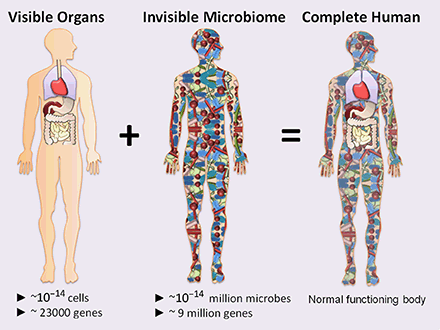Me and My Microbiome
What is a microbiome? On your skin and in your body live trillions of different bacteria, fungi, parasites and viruses. Before you go and run for the nearest hand sanitizer or antibiotic, realize that these “germs” coexist with us in a healthy symbiotic relationship.
Half of the cells that are found in and on you are not “your” cells at all, but are in fact thousands of different microorganism species.
When we break down the word microbiome, we see that “micro” means “small or minute” and “-biome” means “a major ecological community type (such as tropical rainforest, grassland, or desert)” Just how a tropical rain forest is made up of thousands of different organisms working in harmony with each other to benefit the whole environment, your own human cells form an ecological community with different bacteria, viruses, fungi, and parasites to benefit the human body.
New scientific research is now labeling the microbiome as a supporting organ of your body. The research is showing how the microbiome supports and promotes a lot of our human functions such as digestion and immunity.
What I find most fascinating about the microbiome is that the microorganisms that make up the microbiome, or microbiota, are completely unique for each person. Your microbiome is different than my microbiome, similar to how your fingerprint is unique to you alone.
The external microbiome is first initiated during our delivery as we travel through the birth canal and the internal microbiome is first established through the drinking of our mother’s breast milk. This first exposure is completely dependant on the microbiota found in your mother.
As we develop, so does our microbiome develop through different positive or negative environmental, dietary, and stress responses. The microbiome consists of both potentially harmful microorganisms and helpful microorganisms. A higher population of the “bad” can lead to negative effects of sickness and susceptibility to disease processes.
In a healthy or balanced microbiome, a symbiotic relationship occurs between all the “good” and “bad” microbiota and health can be maintained. The scale can be tipped in the negative through poor diet choices, compromised immunity, stress, antibiotic overuse and other over-sterilization procedures. Ways to promote a healthy microbiome is to eat and consume probiotic and prebiotic rich foods, beneficial stress coping mechanisms, and decreasing the use of general antimicrobial products to name a few.
Before answering what a Prebiotic is, it would actually be better to define a Probiotic first. A probiotic is a microorganism, usually a bacteria or yeast, that is beneficial for the body and its microbiome. These “good” microorganisms help maintain or improve the other "good" microorganisms in the body.
The greater ratio of “good” to “bad” bacterium help keep the proper balance of the microbiome. This healthy balance comes down to real estate. If the “good” bacteria are in higher numbers, they will take up more space on the skin and in the digestive tract, thus preventing the “bad” bacteria from overpopulating.
For example: Let’s say you take an antibiotic one day when you feel ill. Antibiotics are designed to kill any and all bacteria they come across by disrupting their cell wall and DNA structure. As of yet, there is no such thing as a ‘probiotic sparing antibiotic.”
So as the antibiotic passing through your digestive tract, a large percentage of the bacteria, both the “good” and the “bad” get wiped out. This now creates a two-pronged problem. The majority of the more aggressive “bad” bacteria have started to create an immunity to antibiotics. They have learned through their fast reproduction rates, to strengthen their cell walls so the antibiotics can’t penetrate them.
As the antibiotic passes through the digestive system killing off their “bacterial real estate competition”, they survive unscathed. They now have more space to repopulate and spread their domain. This throws off the normal balance and can create not just illness, but disease. This concept is often ignored by those who promote an antiquated view of the Germ Theory. In fact, the majority of illnesses we take antibiotics for are actually viral in nature and antibiotics don’t effect viruses at all.
So what is a Prebiotic? Prebiotics are the nutrients for the bacterium of the microbiome. Prebiotics are usually high in fiber and act as food for the human microflora. Foods that are high in prebiotics include oats, barley, onions, garlic, and asparagus. Prebiotics help improve the balance of the microbiome by keeping the “good” bacteria fed, alive, and healthy.
The details surrounding the microbiome is new, but the overall conversation of “nurture/nature” “environment/heredity” or “soil/seed” when it comes to health and disease is not. Nurturing the soil of the environment might be a newly accepted concept by the mainstream medical community, but it is nothing new to Chiropractic.
“While other professions are concerned with changing the environment to suit the weakened body, Chiropractic is concerned with strengthening the body to suit the environment.” - B.J. Palmer, D.C.
Chiropractic wants to help nurture your nature so you can live in harmony with your environment, not at odds with it. Helping your Nerve System function without a vertebral subluxation is our main way of achieving this balance. A vertebral subluxation creates a disruption in bodily function. This can contribute to overall system malfunction, which negatively effects the expression of health.
- Jarek Esarco, DC, CACCP
Related Blogs:
Breaking News! Germ Theory Disproved! In 1892!
Neuroimmune Dynamics: Immunostasis
Vertebral Subluxwhat!?








